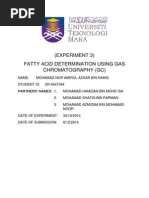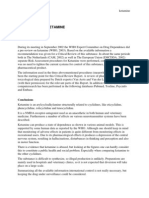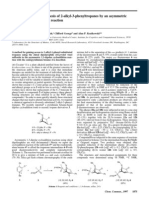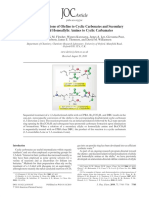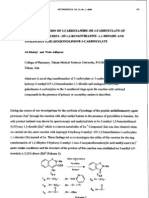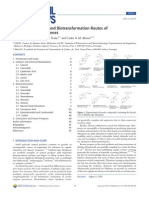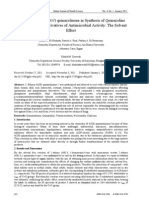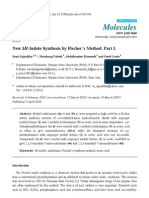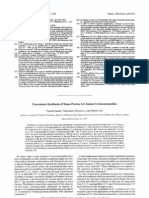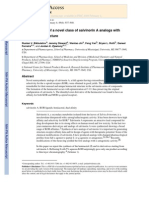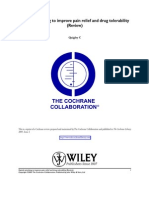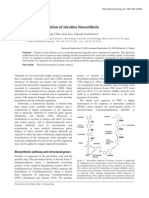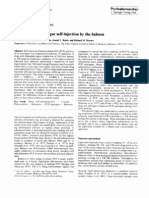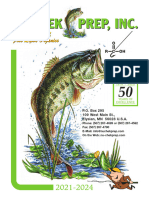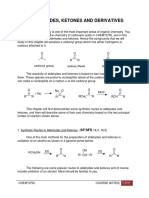Anthony R. Lingham Et Al - Studies Towards The Synthesis of Salvinorin A
Anthony R. Lingham Et Al - Studies Towards The Synthesis of Salvinorin A
Uploaded by
Bic0000Copyright:
Available Formats
Anthony R. Lingham Et Al - Studies Towards The Synthesis of Salvinorin A
Anthony R. Lingham Et Al - Studies Towards The Synthesis of Salvinorin A
Uploaded by
Bic0000Original Title
Copyright
Available Formats
Share this document
Did you find this document useful?
Is this content inappropriate?
Copyright:
Available Formats
Anthony R. Lingham Et Al - Studies Towards The Synthesis of Salvinorin A
Anthony R. Lingham Et Al - Studies Towards The Synthesis of Salvinorin A
Uploaded by
Bic0000Copyright:
Available Formats
Full Paper
Aust. J. Chem. 2006, 59, 340348
CSIRO PUBLISHING
www.publish.csiro.au/journals/ajc
Studies Towards the Synthesis of Salvinorin A
Anthony R. Lingham,A Helmut M. Hgel,A and Trevor J. RookA,B
A B Corresponding
RMIT University, School of Applied Sciences, Melbourne VIC 3001, Australia. author. Email: trevor.rook@rmit.edu.au
Salvinorin A 1, a psychoactive neoclerodane diterpenoid from the Mexican sage S. divinorum, has gained interest as a selective -opioid receptor agonist. Non-racemic 3-furylamines 9a and 9b have been prepared from (+)-pseudoephedrine and ()-ephedrine for application in the stereoselective synthesis of the ketone ring of 1. DielsAlder reaction of 9b with methyl acrylate in aqueous media, followed by selective ether bridge cleavage, has allowed access to the cyclohexenone 17 with preservation of stereochemistry at C2. A model route to the lactone ring has also been achieved through a one-pot deconjugation/esterification procedure of 2-bromocrotonyl chloride 20 to the furyl alcohol 19 followed by Reformatski-mediated ring closure. Manuscript received: 20 December 2005. Final version: 25 May 2006.
Introduction Infusions prepared from the leaves of the Lamiaceae Salvia divinorum (Epling and Jativa-M.) are traditionally used in divinatory rites by the Mazatec Indians of Oaxaca, Mexico. The trans-neoclerodane diterpene salvinorin A 1 has been isolated[1,2] from bioactive fractions of the plant extract and identified to be the principal pharmacologically active component.[3] The absolute stereochemistry of salvinorin A has been determined by several methods.[2,4] Extensive receptor assays have indicated that salvinorin A acts selectively as a potent -opioid receptor (KOR) agonist[5,6] exhibiting similar efficacy to known KOR agonists U69,593 and TRK-820.[7] The biological properties of salvinorin A are unique, considering it is a non-nitrogenous opioid agonist and displays hallucinogenic effects similar to LSD 3, mescaline 4, and DMT 5 (Fig. 1) while lacking structural similarity to these classical alkaloids. It has been reported that the diterpene 1 is localized within glandular trichomes[8] as a secondary metabolite in concentrations up to 0.37% (dry leaf). Salvinorins B 2,[2] C,[9] DF,[10] and G[11] have also been isolated from leaf extracts, along with salvinicins A and B[12] and divinatorins A, B, and C[13] and D and E[11] in low concentrations. So far there have been no reports of isolated metabolites possessing KOR activity higher than that of 1. Recent efforts to elucidate structureactivity relationships of 1 have involved the modification of the C2-acetoxy and C4-ester substituents. The semisynthetic methoxymethyl C2 analogue has shown increased potency as a KOR agonist,[14] and affinity for the -opioid receptor has been reported in analogues containing aromatic C2-ester substituents.[15] C4-modified analogues have been reported to possess reduced binding affinity[16]
O RO
O O H H O O N N
N H
Salvinorin A 1: R Salvinorin B 2: R
O
Ac H
N O O NH2 N H
Fig. 1.
and by-products from ester hydrolysis under basic conditions have been shown to involve the oxidation of ring A.[17] Growing concern in regards to its potential as a drug of abuse has led to prohibition of both plant material and active component in some countries (Australia, Denmark, Italy).[18] However, interest by the medicinal and pharmacological community has grown, as novel psychotomimetic structures offer opportunities to explore the role of the receptor systems in humans. The use of KOR agonists has gained interest as a novel approach to relief from CNSacting drug dependence.[19] However such medication may be problematic because 1 produces dysphoric effects, which are considered undesirable in medicinal use.
10.1071/CH05338 0004-9425/06/050340
CSIRO 2006
Synthesis of Salvinorin A
341
Many labdane and clerodane diterpenes possess similar structures to salvinorin A but differ vastly in bioactivity. The furyl lactone moiety in salvinorin A is identical to that observed in the molluscicide ricciocarpin A[20] and has been found necessary for the insect antifeedant properties of bacchotricuneatin A.[21] Syntheses of neoclerodane diterpenes are not common in the literature and novel synthetic pathways are necessary to prepare these biologically important diterpenes. In this paper we wish to report on our progress towards an enantioselective route to ketone ring A of 1, along with preliminary studies towards a model route to the lactone ring C. Retrosynthetic Analysis Dissection of the tricyclic ring structure at C9/C10 and C6/C7 presents a functionalized cyclohexanone, ring A 18, and an ,-unsaturated lactone, ring C 22, as precursors in a convergent synthesis (Scheme 1). Stereocentres adjacent to ketone and ester functionalities contain acidic protons and were identified as potential sites for racemization during preparation and purification. Cyclohexanone ringA was retrosynthetically derived from the DielsAlder adduct between a 3-furylamine 9 and methyl
15 14 13
acrylate (MAC). Hydrolysis of the amine substituent provides a direct route to the 7-oxabicyclo[2.2.1]heptane (or 7-oxanorbornane) species 12 (Scheme 3). The chemistry of 7-oxabicyclo[2.2.1]heptane compounds has been extensively explored and reviewed by Vogel and Le Drian.[22] Ring opening of 12 to the cyclohexenone 16 provides the core of the ketone ring present in both 1 and 2 (Scheme 5). Acetylation followed by 1,4-addition allows access to the convergent precursor 18. Ring C was derived from rudimentary precursors, as -halovinyl esters may be achieved through a deconjugation/esterification procedure using -bromocrotonyl chloride. Reformatski-mediated ring closure of the -bromo ester followed by dehydration leads to the lactone ring C. Coupling of 18 and 22 should be possible through a Michael-type addition using methodology developed by Stork et al.,[23] followed by olefin metathesis and hydrogenation. Results and Discussion 7-Oxa[2.2.1]bicycloheptane structures serve as useful intermediates in the preparation of specifically functionalized molecules for natural product synthesis. Hetero-substituted furans have found use as reactive dienes in the preparation of 7-oxa[2.2.1]bicycloheptane structures using Diels Alder methodology. A general method for the preparation of 3-furylamines has been developed by our group[24] and products have shown high reactivity in cycloaddition reactions with methyl acrylate.[25] This has allowed the preparation of racemic 7-oxabicyclo[2.2.1]heptanone structures and investigation into their chemical transformations has been part of ongoing studies. Face selectivity in the cycloaddition reactions of chiral 3-furylamines has been reported by Schlessinger et al.[26] and is mediated by steric interactions of a proline-derived auxiliary. This methodology has been applied successfully to the total synthesis of (+)-cyclophellitol.[27] Our current investigation has led us to examine the utility of the naturally occurring ephedrine isomers as asymmetric amine substituents on the furan moiety. Furans prepared from (1S,2S)-(+)-pseudoephedrine 9a and (1R,2S)-()-ephedrine 9b were obtained in high yields from the starting amines by optimized procedures. Under conditions required for cyclization, tetrahydropyran-2-yloxy (THP) group migration to the benzylic oxygen was observed in NMR and GC-MS analysis, indicating the formation of furan 8 (Scheme 2). THP deprotection was subsequently performed by gentle heating with p-toluenesulfonic acid in ethanol. Furan products were stable for long periods upon storage at 18 C. Studies of DielsAlder reactions involving achiral 5-methyl-3-furylamines with MAC demonstrated both dichloromethane (DCM) and water to be suitable reaction media.[25] Cycloadditions of 9a and 9b carried out in DCM were quantitative as were heterogeneous reactions in water with the aid of ultrasonic irradiation. Furylamines containing aromatic substituents have been shown to react to completion without sonication,[25] suggesting that the sonication in this
O
16
O O H
21 22 11
12
O
17
H
8
O
1 10 3 5 6 19 18 20
O
23
1
O O O O
A C
O O O O
18
22
R1
R2 N
O Cl
Br OH
MAC
19
20
Scheme 1.
Retrosynthesis of salvinorin A.
342
A. R. Lingham, H. M. Hgel, and T. J. Rook
(a)
OTHP O N
OH
OTHP
(b, c)
OTHP N
(d)
N
OH
9a
(e) 6 (b, c, d)
O N
OH
9b
Scheme 2. (a) (+)-Pseudoephedrine, THF; (b) TFA, DCE; (c) aq. NaOH; (d) p-TsOH, EtOH, 60 C; (e) ()-Ephedrine.
OH
(a) 9a or 9b MAC
N O
O O
10
O 3
1 2 O
11
O
5 6
O O O O
(b)
12a endo
12b exo
case is simply a means of suspending the furan in solution, rather than a rate-enhancing phenomenon. NMR studies on the cycloadduct of 9a prepared in DCM showed the product to exist preferentially as the oxazolidine 11. The disappearance of both the spiro and methylene carbon signals at C 108.5 and 41.5 ppm in acidic D2 O suggests facile reversion to the enamine 10, although full characterization of 10 could not be obtained. Upon heating in strong acidic solutions (pH 1), 10 underwent a retro DielsAlder reaction rather than hydrolysis. This led to a loss in enantio- and diastereomeric excesses along with slow decomposition.After many attempts, effective hydrolysis was achieved by gentle heating in a buffer solution of sodium acetate/acetic acid (pH 5.5) to give the ketones 12a and 12b in good combined yields (8190%; Scheme 3). Diastereomeric ratio (endo/exo) and enantiomeric excesses (e.e.) of 12a and 12b were measured by chiral gas chromatography on a diethyl-tert-butyl--cyclodextrin column (MeGA, Italy; Table 1). Chiral GC analysis revealed both ephedrine isomers to direct face-selectivity in the same manner, whereas the diastereomeric outcome was quite different. Small-scale reactions carried out using 9a in aqueous media achieved good enantioselectivity for both diastereomers of 12. Reasonable enantiomeric excess was observed for the exo-cycloadduct using 9b, achieving 60% e.e. and providing a 1:1 ratio of diastereoisomers when bath temperature was maintained between 10 and 20 C (Table 1, entry 4). Aqueous reactions on multigram scales required three equivalents of acrylate to ensure the consumption of all starting materials, but did not perform as well and a loss of 12 to 15% e.e. was commonly encountered. The addition of miscible co-solvents (DMF, dioxane, alcohols) or surfactants (TBAI), to aid in the aqueous solubility of reagents, led to a noticeable decrease in enantioselectivity. High selectivity was observed for the endo-adduct prepared from 9a in DCM and the multigram reaction performed comparably well (80% e.e.). Clean reduction of the enamine 10a was achieved using sodium triacetoxyborohydride,[28] performed from NaBH4 in acetic acid (Scheme 4). The distilled amine 13 underwent crystallization as the perchlorate salt to provide a diastereomerically pure product as shown by 1 H and 13 C NMR data. X-Ray crystal structure data on the major isomer revealed facial selectivity in the [4 + 2] cycloaddition for the (1S,4S) isomer (Fig. 2). The enamine reduction was observed to be selective for the less-hindered exo-face.
Scheme 3.
(a) DCM or water; (b) AcOH, NaOAc, H2 O. Table 1. Enantioselective DielsAlder reactions using ephedrine auxiliaries Results produced on 1.0 mmol scales
Run 1 2 3 4
A
MAC [equiv.] 9a 9a 9b 9b 3.0 1.5 3.0 1.5
Solvent DCM Water DCM Water
T [ C] 50 to rt 1020 50 to rt 1020
Time [h] 8.0 1.5 8.0 1.5
endo/exoA 99:1 9:1 3:1 1:1
e.e. (12a) 85 75 56 18
e.e. (12b) n.d. 75 46 60
Yield [%]B 90 83 87 81
B Combined
Ratio of diastereoisomers (12a/12b). yield of endo and exo products.
Synthesis of Salvinorin A
343
Recrystallization of an enantioenriched mixture of 12b in ether at 18 C gave a single enantiomer as indicated by chiral GC analysis. (+)-12b enriched in the supernatant as the racemic precipitate was removed and was found to be a colourless resin at room temperature. Ether cleavage of 12a and 12b using tert-butyldimethylsilyl(trifluoromethane)sulfonate (TBDMSOTf) in the presence of base as reported by Vogel et al.[29] gave unexpected results. The appearance of furan signals in 13 C NMR and a propionate ester in 1 H NMR analysis indicated CC bond cleavage had occurred between the ester and the tertiary bridgehead (C1, C2) to give 14. Ring-opening reactions using lithium hexamethyldisilazide (LHMDS)[30] in the absence of silylating agent gave the furanone 15 as confirmed by COSY and HMBC two-dimensional NMR data (Fig. 3). Desilylation of 14 with tetra-n-butylammonium fluoride (TBAF) revealed the formation of 15 by GC-MS analysis. BBr3 ring cleavage followed by quenching in collidine gave clean conversion into the desired cyclohexenone 16 (61%) with no detectable epimerization at C5. COSY analysis showed correlations between H1H6, H6H5 indicating that the six-membered ring was intact. The appearance of the olefinic proton at H 6.00 ppm gave evidence of the ,-unsaturated system and connectivity was confirmed by HMBC analysis. Subsequent acetylation of the alcohol was performed in the quenching solution without isolation to give 17 in 40% yield from 12b (Scheme 5). NOESY analysis of 17 showed correlation between H1H5 which was absent in
the C5 epimer confirming the retention of relative stereochemistry. Interestingly, BBr3 cleavage on the endo-product 12a gave the corresponding cyclohexenone in 60% yield but stereochemistry at C5 was not retained. Ether cleavage was unsuccessful using BBr3 /Me2 S, TiCl4 , FeSO4 , and ZrCl4 and returned only starting material. Attempted isolation of 16 and 17 by flash column chromatography on silica, neutral alumina, and fluorosil led to almost complete isomerization at C5. Semi-preparative HPLC was trialled and we were pleasantly surprised to achieve complete separation on a Phenomenex C-18 column using acetonitrile/water as eluent. The C5 stereoisomer was not observed in GC and NMR studies on products 16 and 17 after purification by HPLC. 1,4-Addition with vinyl Gilman reagent is expected to produce the convergent precursor ring A and is the subject of future work. Studies Towards the Synthesis of Ring C Intramolecular cyclization of an ester side chain by an aldol or Reformatski reaction provides a practical formation of lactone fragments in several syntheses.[31] Likewise, the preparation of lactone 22 was thought possible by ring closure of a vinylacetic ester. 4-(Furan-3-yl)-4-hydroxybutan-2-one 19 was prepared by an aldol reaction between acetone and 3-furaldehyde based on an optimized literature procedure. Dehydration of 19 was facile in the presence of acidic and basic reagents at ambient temperature. Literature searches revealed a mild preparation of vinyl acetic esters from crotonyl chlorides.[32] Iwakura and co-workers
TBDMSO
(a) 9a
O O
OH
O
O
O O
O O
10a
14
15
Fig. 3.
H
O O
O O O N
(b) (70%)
O
(a) (61%)
O O
RO 5
4 6 1 2
11a
12b
O OH
16 R 17 R
O O O
H Ac
(1:10)
N O O HO O O O N
(b)
Minor isomer (1R,4R)
13 Major isomer (1S,4S)
18
Scheme 4.
(a) DCM, 50 C to rt; (b) NaBH4 , AcOH.
Scheme 5.
(a) (i) BBr3 , DCM, (ii) collidine, DCM; (b) AcCl.
344
A. R. Lingham, H. M. Hgel, and T. J. Rook
have reported the action of triethylamine (TEA) on crotonyl chloride to give a ketene intermediate which provides the ,-unsaturated esters in good yields upon reactions with secBuOH (Scheme 6). To date this methodology appears not to have been used in the preparation of larger organic molecules. Initial reactions were performed using crotonyl chloride. Upon reaction with 19, esterification was successful providing the deconjugated ester in high yield. Subsequent ring closure using LDA failed and attempts at vinylic bromination using Br2 /dibenzoylperoxide in CCl4 led to a mixture of brominated products. 2-Bromocrotonyl chloride 20 (R = Br) was then prepared in three steps from crotonic acid by literature methods.[33,34] Under conditions described by Cardillo et al.,[35] the reaction of 19 in the presence of 20 gave the deconjugated -bromoester 21 as shown by the appearance
C9 O7 C1 C4 C3 C6 C5 C10 C3 C1 C4 C5 N11 C10 C2 O12 C2 O11 C8 O12
of terminal olefinic signals in 1 H NMR. The formation of the ketene was accompanied by the appearance of a deep blue colour which gradually progressed to dark red as esterification took place. Ratios of ,- to ,-esters obtained were 10:1 and results were surprisingly reproducible given that the reaction mixture had a tendency to cake and required mechanical stirring to ensure proper mixing. Ring closure of 21 to the lactone 22 was achieved by a Reformatski reaction using Rieke zinc in THF. Conveniently, dehydration of the intermediate alcohol was achieved by prolonged stirring in the aqueous acidic quenching solution, producing 22 in high purity and yield (92%; Scheme 7). Further studies are focussed on an efficient stereoselective aldol addition procedure of acetone to 3-furaldehyde to complete ring C in the convergent synthetic pathway. Conclusions The DielsAlder reaction of 5-methyl-3-aminofurans possessing (+)-pseudoephedrine and ()-ephedrine amine substituents have demonstrated face selectivity in reactions conducted in both organic and aqueous reaction media. The diastereomeric outcome has been observed to be dependant on both the amine substituent and the polarity of the solvent. As a result, both exo- and endo-products 12a and 12b have been prepared in enantioenriched form using the methodology described. Lewis acid assisted ether cleavage using boron tribromide has provided conversion of 12b to the corresponding cyclohexenone 16 in moderate yields, and subsequent acetylation has been carried out in a two-step, one-pot procedure providing clean reaction mixtures of 17 with total retention of stereochemistry at C5. Since both acetoxy and ester substituents occupy a single face on the cyclohexanone ring, further work towards 1,4conjugate addition is expected to occur at the opposite face due to steric considerations. A model route to the lactone ring of 1 has also been accomplished under mild reaction conditions and in high yields.
O
C9
C6 C7
C8
Fig. 2. ORTEP drawing of the perchlorate salt of (1S,2S,4S,5S)methyl 5-(N-((1S,2S)-1-hydroxy-1-phenylpropan-2-yl)-N-methylamino)1-methyl-7-oxabicyclo[2.2.1]heptane-2-carboxylate 13.
O
TEA
Cl R
sec -BuOH
O R O R
HCl
Scheme 6.
O H OH O
R = H, Br.
(a)
O O O Cl Br O
O O
19
(d)
Br
(e)
O HO
(b, c)
21 20
22
Scheme 7.
(a) Acetone, dil. NaOH; (b) (i) Br2 , DCM, (ii) pyridine; (c) SOCl2 ; (d) TEA, Et2 O; (e) (i) Rieke zinc in THF, (ii) H3 O+ .
Synthesis of Salvinorin A
345
Experimental
Unless noted, materials were obtained from Aldrich and used without further purification. Diethyl ether and THF were dried first with CaH2 , then distilled from sodium/benzophenone before use. Dry acetone (BDH) was obtained by refluxing over KMnO4 followed by distillation and storage over molecular sieves (4 ). Triethylamine was dried over KOH pellets before use. 1 H and 13 C NMR spectra were recorded on a Bruker Avance 300 (300 MHz) NMR spectrometer and are indirectly referenced to TMS through CHCl3 . FTIR spectra were recorded on a PerkinElmer Spectrum 2000 Fourier transform IR spectrometer. GC-MS data was recorded using a Hewlett Packard 6890 GC with BPX5 column, and Hewlett Packard 5973 Mass-Selective Detector. Chiral GC separation was achieved using a diEt-TBS--CD column (MeGA), 20 m, 0.25 mm 0.25 m (film thickness). Semipreparative HPLC was performed using a Varian Prostar (Model 210), with Phenomenex C18 column (250 10 mm, 5 m ODS (3), 50 10 mm, 5 m ODS (3) guard column). Separation was achieved using ACN/H2 O (55/45) at 3.5 mL min1 flow rate, with UV-Vis detection. Reactions performed under ultrasonic irradiation were performed using an Elma Transsonic Digital S, 40 kHz variable power ultrasonic bath. Optical rotations were determined on a PerkinElmer 241 MC Polarimeter at 690 nm, 20 C, and concentration c [g per 100 mL]. 5-(Tetrahydropyran-2-yloxy)pent3-yn-2-one 6 was prepared by previously reported procedures.[24] (E)-2Bromobut-2-enoic acid was prepared by method of Pfeiffer in a two-step procedure.[33] (E)-2-Bromobut-2-enoyl chloride 20 was prepared from (E)-2-bromobut-2-enoic acid by method of Klein and Zitrin[34] and was freshly distilled before use. 1 H and 13 C NMR spectra reported for isolated compounds of purity >97% unless quoted as a mixture. Where 13 C data is included assignments are based on 2D experiments (DEPT, HMQC, HMBC, COSY) in each case. Preparation of Furans 9a and 9b Preparation of 7 (1S,2S)-(+)-Pseudoephedrine (1.62 g, 9.8 mmol) in warm dry THF (15 mL) was added quickly with stirring to neat 5-(tetrahydropyran-2yloxy)pent-3-yn-2-one (1.95 g, 10.7 mmol) and allowed to stir at room temperature for 4 h or until the Michael addition was complete as monitored by GC-MS. The THF was removed under vacuum to leave a 1:1 mixture of E/Z-4-( N-((1S,2S)-1-hydroxy-1-phenylpropan-2-yl)-Nmethylamino)-5-(tetrahydro-2H-pyran-2-yloxy)pent-3-en-2-one 7 as a viscous yellow resin (>97%, GC-MS). H (300 MHz, CDCl3 ) 7.50 7.25 (5H, m), 7.507.25 (5H, m), 4.67 (1H, s), 4.67 (1H, s), 4.44 (1H, d, J 8.7), 4.44 (1H, d, J 8.7), 4.02 (1H, d, J 10.6), 3.97 (1H, d, J 10.6), 3.87 (1H, m), 3.87 (1H, m), 3.56 (1H, m), 3.56 (1H, m), 3.57 (1H, d, 1 J 10.6), 3.49 (1H, d, J 10.6), 2.952.75 (2H, m), 2.952.75 (2H, m), 2.46 (3H, s), 2.44 (3H, s), 2.29 (3H, s), 2.27 (3H, s), 1.901.47 (6H, m), 1.901.47 (6H, m), 1.06 (3H, d, J 6.0), 1.06 (3H, d, J 6.0). C (75 MHz, CDCl3 ) 207.4, 207.3, 139.6, 139.6, 128.4, 128.4, 128.2, 128.2, 127.0, 127.0, 99.5, 99.5, 96.4, 96.4, 85.9, 85.8, 72.6, 72.1, 70.4, 69.9, 65.2, 65.2, 62.3, 62.1, 46.5, 46.0, 49.8, 49.7, 32.3, 32.3, 32.2, 32.1, 30.7, 30.7, 25.6, 25.6, 19.4, 19.3, 15.1, 14.9. m/z 347 (M+ , 0.1%), 233 (16.7), 232 (93.7), 205 (13.5), 149 (10.3), 148 (100), 118 (34.9), 117 (19.0), 115 (7.1), 91 (11.9), 85 (19.8), 57 (7.9), 56 (17.5). Preparation of 9a Freshly prepared 7 from the previous step was dissolved in 1,2dichloroethane (DCE; 135 mL). Anhydrous trifluoroacetic acid (5 mL) was added in one portion and the solution stirred at ambient temperature for 40 min after which time the solution had become dark red in colour. The solution was poured into a mixture of 4 M NaOH (100 mL) and ice (300 g) then immediately shaken vigorously in a separating funnel. The organic layer was separated and the aqueous layer extracted with DCM (3 100 mL). Removal of the THP Group: The combined organic layers were evaporated and the orange resin 8 was re-dissolved in ethanol (200 mL) and used without purification. p-Toluenesulphonic acid (4.0 g, 23.3 mmol) was added in one portion and the solution stirred for 4 h at 60 C.
The ethanol was then evaporated under vacuum and the residue dissolved in HCl (250 mL, 1 M aq.). The aqueous acidic solution was extracted with DCM (3 150 mL) and the organic layers re-extracted with HCl (3 100 mL, 1 M aq.). The combined aqueous phases were extracted once more with DCM (50 mL) and ice (200 g) was added to chill the solution to 5 C. The solution was then basified with ice-cold 4 M NaOH to pH 14, followed by extraction with DCM (4 100 mL). The organic phases were combined, dried with Na2 SO4 and evaporated to leave (1S,2S)-2-( N-methyl-N-(5-methylfuran-3-yl)amino)-1phenylpropan-1-ol 9a as a viscous dark yellow oil (2.26 g, 94% overall yield calculated from (+)-pseudoephedrine, >97% pure GC-MS). If necessary, discolouration and impurities of pseudoephedrine can be removed by dissolving the material in Et2 O and rapidly eluting the solution through a short silica column, deactivated with triethylamine. H (300 MHz; CDCl3 ) 7.457.25 (5H, m, H-2 , H-3 , H-4 , H-5 , H-6 ), 6.88 (1H, s, H-2 ), 5.95 (1H, s, H-4 ), 4.47 (1H, d, J 9.6, H-1), 3.49 (1H, s, OH), 3.26 (1H, dq, 1 J 6.6, 2 J 9.6, H-2), 2.62 (3H, s, NCH3 ), 2.25 (3H, s, H-6 ), 0.81 (3H, d, J 6.6, H-3). C (75 MHz; CDCl3 ) 152.5 (C5 ), 141.5 (C-1 ), 140.9 (C-3 ), 128.6 (C-3 , C-5 ), 128.2 (C-4 ), 127.5 (C-2 , C-6 ), 125.5 (C-2 ), 101.3 (C-4 ), 75.1 (C-1), 64.8 (C-2), 33.0 (NCH3 ), 14.1 (C-6 ), 10.0 (C-3). m/z 245 (M+ , 1.0%), 139 (11.1), 138 (100), 96 (8.7), 94 (6.3), 77 (8.7), 43 (7.9), 42 (11.9). Compound 9b was prepared following an identical procedure. DielsAlder Reactions of 9a and 9b Chiral gas chromatography analyses were conducted using a Hewlett Packard 5890 GC. A DiEtTBS--CD coated column of dimensions 20 m, 0.25 mm 0.25 m (film thickness) (MeGA) was used. Flame ionization detection was used to monitor analytes, and was operated at 230 C. Injections were performed at 200 C using split (50:1) conditions, with hydrogen carrier gas, flow rate of 1.33 mL min1 , and linear velocity of 40.07 cm s1 . Temperature programming conditions were optimized for the separation of stereoisomers of 11. The GC oven was heated to 60 C and ramped to 180 C at 2 C min1 (held for 20 min). Preparation of 11a The phenylpropanol 9a (150 mg, 0.61 mmol) was dissolved in DCM (20 mL) and cooled to 50 C. Methyl acrylate (158 mg, 1.84 mmol) was then added and the solution allowed to warm to 10 C where it was kept for 2 h, then gradually warmed to room temperature and stirred overnight. Evaporation of the solvent and excess acrylate under vacuum gave a mixture of (1S,4S,5S)/(1R,4R,5R)-methyl 3 ,4,4 S-trimethyl5 S-phenylspiro[7-oxa-bicyclo[2.2.1]heptane-2,2 -[1,3]oxazolidine]-5carboxylate 11a as a viscous red semisolid (199 mg, 97% yield via GCMS, d.r. >99:1). H (300 MHz, CDCl3 ) 7.407.22 (5H, m, arom., H-2 , H-3 , H-4 , H-5 , H-6 ), 4.60 (1H, d, J 15.1, H-5 ), 4.54 (1H, s, H-1), 3.73 (3H, s, H-10), 3.05 (1H, dq, 1 J 6.7, 2 J 9.1, H-4 ), 2.70 (1H, m, H6A ), 2.46 (3H, s, NCH3 ), 2.43 (1H, m, H-3A ), 2.04 (1H, m, H-6B ), 1.85 (1H, m, H-3B ), 1.64 (3H, s, H-9), 1.26 (3H, d, J 6.7, H-6 ). C (300 MHz, CDCl3 ) 173.2 (C-8), 140.9 (C-13), 128.6 (C-5 , C-3 ), 127.5 (C-6 , C2 ), 126.0 (C-4 ), 108.8 (C-2/2 ), 85.3 (C-4), 83.1 (C-1), 81.8 (C-5 ), 67.1 (C-4 ), 52.1 (C-10), 51.8 (C-5), 41.7 (C-3), 33.9 (NCH3 ), 29.8 (C6), 21.0 (C-9), 13.9 (C-6 ). m/z 331 (M+ , 3.5%), 300 (9.2), 289 (20.8), 288 (100), 272 (12.3), 204 (7.8), 149 (7.4), 148 (68.7), 141 (11.8), 118 (34.0), 117 (27.2), 115 (8.9), 109 (10.7), 91 (14.3), 77 (6.8), 69 (7.4), 56 (14.7), 55 (10.3), 43 (11.4), 42 (11.0), 41 (13.3). (HR-ESI-MS: Found [M]+ , 332.1855. [C19 H26 NO4 ]+ [M]+ requires 332.1862.) An identical procedure was used for the reaction of 9b in DCM. Preparation of 12a To a solution of acetic acid (0.5 mL) and sodium acetate (3 g) in distilled H2 O (15 mL) was added 11a (196 mg, 0.61 mmol) and the solution heated with stirring in an oil bath at 70 C. After 2 h the solution was cooled and extracted with DCM (3 40 mL). The combined organic phases were evaporated and the oil purified by column chromatography on silica gel (pentane/EtOAc 5/1) to give (1S,2S,4S)-methyl 1-methyl-5oxo-7-oxabicyclo[2.2.1]heptane-2-carboxylate 12a as a pale yellow oil (101 mg, 90% yield, 85% e.e., >98% pure GC-MS). NMR spectroscopic data was consistent with the reported values for 12a.[25]
346
A. R. Lingham, H. M. Hgel, and T. J. Rook
Preparation of 12b To 9b (100 mg, 0.41 mmol) was added distilled H2 O (10 mL) followed by methyl acrylate (53 mg, 0.62 mmol) and the solution irradiated in an ultrasonic bath (80% power) for 95 min. The bath temperature was maintained between 10 and 20 C. After removing the excess methyl acrylate under high vacuum at room temperature the solution was extracted with DCM (3 15 mL). The combined organic layers were evaporated and the viscous red semisolid heated in an acidic buffer according to the reported procedure for 12a. The oil obtained was purified by column chromatography on silica gel (pentane/EtOAc 10/1) to provide 12a (30 mg, 40% yield, 18% e.e.) and (1S,2R,4S)-methyl 1-methyl-5-oxo-7-oxabicyclo[2.2.1]heptane-2-carboxylate 12b (31 mg, 41% yield, 60% e.e.). NMR spectroscopic data was consistent with the reported values for 12b.[25] 12b was then crystallized from Et2 O at 18 C until the supernatant solution was enriched to enantiomeric purity as indicated by chiral GC-MS. The Et2 O was evaporated to dryness to leave pure (1S,2R,4S)-(+)-12b (14.5 mg, 19% yield from 9b, >99% e.e.) [] +1.72 (c 1.45, chloroform). An identical procedure was used for the reaction of 9a under aqueous conditions. Preparation of 13 for X-Ray Crystal Structure Analysis NaBH4 (0.87 g, 23.0 mmol) was added portion-wise to glacial acetic acid (35 mL) with cooling in an ice bath and the mixture stirred until the evolution of hydrogen ceased. The heptane carboxylate 11a (2.55 g, 7.7 mmol) in glacial acetic acid (17 mL) was added drop-wise, followed by additional NaBH4 (0.50 g, 13.2 mmol) portion-wise over 30 min. The solution was allowed to stir for 4 h at ambient temperature then poured into distilled H2 O (200 mL) and carefully neutralized with NaHCO3 . The neutral solution was extracted with DCM (3 75 mL) and the combined extracts were dried over Na2 SO4 . Evaporation under vacuum gave a red resin which was bulb distilled (150 C at 0.1 mmHg) to yield (1S,2S,4S,5S)-methyl 5-( N-((1S,2S)-1-hydroxy-1-phenylpropan-2-yl)N-methylamino)-1-methyl-7-oxa-bicyclo[2.2.1]heptane-2-carboxylate 13 as a viscous yellow resin (1.8 g, 70% yield, d.r. 10:1, >98% pure GCMS). H (300 MHz; CDCl3 ) 7.357.22 (5H, arom. m, H-2 , H-3 , H-4 , H-5 , H-6 ), 4.40 (1H, m, H-4), 4.27 (1H, d, J 9.6, H-1 ), 3.78 (3H, s, H-10), 3.12 (1H, m, H-5), 2.78 (1H, m, H-2), 2.76 (1H, m, H-3A ), 2.64 (1H, m, H-2 ), 2.10 (3H, s, NCH3 ), 2.03 (1H, m, H-3B ), 1.64 (2H, m, H-6), 1.57 (3H, s, H-9), 0.66 (3H, d, J 6.7, H-3 ). C (75 MHz; CDCl3 ) 172.7 (C-8), 142.3 (C-1 ), 128.4 (C-5 , C-3 ), 127.8 (C-6 , C-2 ), 127.5 (C-4 ), 87.0 (C-1), 79.4 (C-4), 74.5 (C-1 ), 64.9 (C-5), 63.2 (C-2 ), 53.3 (C-2), 52.5 (C-10), 38.3 (C-6), 33.2 (NCH3 ), 28.0 (C-3), 21.6 (C-9), 7.5 (C-3 ). m/z 333 (M+ not observed), 227 (21.0), 226 (100), 140 (10.0), 137 (5.9), 124 (4.1), 109 (4.0), 84 (3.9), 81 (6.1), 79 (4.7), 58 (11.6). (HR-ESI-MS: Found [M]+ , 334.2013. [C19 H28 NO4 ]+ [M]+ requires 334.2018.) (1R,2R,4R,5R)-Diastereoisomer: C (75 MHz; CDCl3 ) 172.7, 142.3, 128.4, 127.9, 127.5, 87.1, 78.6, 75.1, 65.1, 63.2, 53.1, 52.2, 38.9, 33.2, 28.7, 21.7, 6.7. Crystallization of 13 Through a solution of 13 (1.0 g, 30.0 mmol) in dry Et2 O was bubbled HCl(g) . A white hygroscopic salt precipitated and was quickly filtered and dried in a vacuum desiccator over drying silica. The hydrochloride salt was dissolved in ACN (20 mL) and silver perchlorate (620 mg, 30.0 mmol) was added as the solution was gently warmed (50 C). After 10 min, the solution was filtered and the salt crystallized by slow evaporation of solvent. Recrystallization from hot EtOH gave colourless needles that showed only a single diastereoisomer by 13 C NMR analysis. One final crystallization was performed from ACN by the slow diffusion of Et2 O to give pure (1S,2S,4S,5S)-methyl 5-( N-((1S,2S)-1-hydroxy-1-phenylpropan-2-yl)N-methylamino)-1-methyl-7-oxa-bicyclo[2.2.1]heptane-2-carboxylate perchlorate salt as colourless plates (mp 227 C). H (300 MHz; CD3 CN) 7.27 (5H, arom. br. s, H-2 , H-3 , H-4 , H-5 , H-6 ), 4.76 (1H, s, OH), 4.75 (1H, m, H-4), 4.74 (1H, d, J 10.1, H-1 ), 3.91 (1H, m, J 5.3, H-5), 3.78 (3H, s, H-10), 3.47 (1H, m, H-2 ), 2.95 (1H, apparent
t, H-2), 2.87 (3H, s, NCH3 ), 2.30 (2H, m, H-3), 1.95 (2H, m, H-6), 1.54 (3H, s, H-9), 1.02 (3H, d, J 6.8, H-3 ). C (75 MHz; CD3 CN) 174.8 (C8), 140.1 (C-1 ), 130.0 (C-4 ), 129.7 (C-3 , C-5 ), 128.3 (C-2 , C-6 ), 88.4 (C-1), 77.0 (C-4), 72.5 (C-1 ), 67.8 (C-2 ), 65.3 (C-5), 53.5 (C-10), 52.5 (C-2), 35.6 (C-6), 35.1 (NCH3 ), 30.7 (C-3), 20.8 (C-9), 8.7 (C-3 ). Crystal Data for 13. C19 H28 ClNO8 , Mw 433.87, T 293(2) K, 1.54180 , orthorhombic, space group P21 21 21 , a 8.511(2), b 15.356(5), c 0.839(3) , 90.00, 90.00, 90.00 , V 2070.1(9) 3 , Z 4, Dc 1.392 Mg m3 , (CuK ) 2.025 mm1 , F(000) 920, crystal size 0.20 0.10 0.02, 2462 reflections measured, 2365 independent reflections (Rint 0.0230); the final wR(F2 ) was 0.1371 (all data) and final R was 0.0496 for 2006 unique data [I > 2(I)]. Goodness of fit on F2 1.071. Crystallographic data for the structure reported has been deposited with the Cambridge Crystallographic Data Centre (CCDC; www.ccdc.cam.ac.uk/products/csd/request) as deposition no. 288601. Ether Cleavage of 12 Preparation of 14 To 12a (100 mg, 0.54 mmol) in dry benzene (1.0 mL) under a dry (N2 ) atmosphere was added a solution of CF3 SO3 (But )Me2 (0.43 g, 1.63 mmol) and triethylamine (0.21 g, 2.12 mmol) in benzene (1.5 mL) over 1.5 h. The solution was stirred at ambient temperature for 4 h then poured into Et2 O (15 mL) and washed with 1 M HCl (10 mL) followed by 5% NaHCO3 solution (10 mL). The organic phase was evaporated under reduced pressure and the resin subject to column chromatography on silica gel to afford 3-[(3-tert-butyldimethylsilanyloxy)-5-methyl-furan2-yl]propionic acid methyl ester 14 as a yellow oil (111 mg, 69% yield). H (300 MHz; CDCl3 ) 5.66 (1H, s, H4 ), 3.70 (3H, s, H4), 2.85 (2H, apparent t, J 8.5, H2), 2.60 (2H, apparent t, J 8.5, H3), 2.16 (3H, s, H6 ), 0.96 (9H, s, H3 ), 0.14 (6H, s, H2 ). C (75 MHz; CDCl3 ) 173.6 (C1), 148.2 (C2 ), 138.4 (C3 ), 136.9 (C5 ), 103.2 (C4 ), 51.8 (C4), 32.8 (C2), 25.8 (C3 ), 20.7 (C3), 18.2 (C2 ), 14.2 (C6 ), 4.5 (C1 ). m/z 298 (M+ , 18.3), 242 (10.3), 241 (60.3), 226 (15.1), 225 (81.0), 199 (19.0), 169 (9.5), 167 (25.4), 135 (31.7), 131 (37.3), 111 (27.0), 90 (7.9), 89 (98.4), 75 (23.8), 74 (9.5), 73 (100), 59 (34.9), 55 (7.1), 45 (10.3), 43 (18.3). Preparation of 15 Under an inert (N2 ) atmosphere a solution of 12b (100 mg, 0.54 mmol) in dry THF (2.5 mL) was cooled to 78 C in a dry ice/acetone bath. LHMDS (1.35 mmol, 1.35 mL, 1 M in THF) was then added dropwise and the solution stirred at 50 C for 1.5 h.An additional volume of LHMDS (0.95 mmol, 0.95 mL, 1 M in THF) was added and the solution stirred at 45 C for 30 min. The mixture was then quenched with saturated NH4 Cl (10 mL), and extracted with DCM (3 15 mL). The combined organic layers were evaporated and the product was subject to column chromatography on silica gel (pentane/EtOAc 5/3) to give methyl 3-(2,3-dihydro-5-methyl-3-oxofuran-2-yl)propanoate 15 (63 mg, 63% yield). H (300 MHz; CDCl3 ) 5.44 (1H, s, H4 ), 4.49 (1H, dd, 1 J 4.9, 2 J 7.7, H2 ), 3.67 (3H, s, H4), 2.46 (2H, m, H2), 2.27 (1H, m, H-3A ), 2.23 (3H, s, H6 ), 2.02 (1H, apparent sextet, J 7.7, H-3B ). C (75 MHz; CDCl3 ) 204.3 (s, C3 ), 190.5 (s, C5 ), 173.1 (s, C1), 104.6 (d, C4 ), 85.0 (d, C-2 ), 52.0 (q, C4), 29.2 (t, C2), 26.4 (t, C3), 17.0 (q, C6 ). m/z 184 (M+ , 26.2), 153 (33.3), 152 (34.9), 125 (14.3), 124 (19.0), 112 (7.1), 111 (100), 110 (15.9), 98 (42.9), 85 (20.6), 71 (11.9), 69 (14.3), 68 (58.7), 59 (13.5), 57 (11.9), 55 (81.0), 43 (42.9), 42 (11.1). Preparation of 16 To a racemic solution of 12b (75 mg, 0.41 mmol) in dry DCM (100 mL) at 1 C was added BBr3 (0.3 mL, 0.30 mmol, 1 M in DCM) at once under dry N2 . The solution was stirred at 1 C for 10 min then quickly poured into a well stirred quenching solution of 2,4,6-collidine (3 g) in DCM (25 mL, LR). The solution was stirred at ambient temperature for 35 min, then extracted with HCl (3 75 mL, 1 M aq.). The organic phase was evaporated to give a mixture of compounds as a yellow/brown resin. The sample was purified by semi preparative HPLC (tR 5.1 min, max 235 nm) to give (1R,5S)/(1S,5R)-methyl-5-hydroxy-2methyl-4-oxocyclohex-2-enecarboxylate 16 as a colourless oil (46 mg, 61% yield). max (neat)/cm1 3452m, 2956w, 2922w, 2856w, 1735s,
Synthesis of Salvinorin A
347
1683s, 1438m, 1379w, 1261m, 1197m, 1164m, 1106s. H (300 MHz; CDCl3 ) 6.00 (1H, s, H3), 4.05 (1H, dd, 1 J 13.5, 2 J 5.5, H5), 3.75 (3H, s, H9), 3.55 (1H, m, H1), 2.52 (1H, dt, 1 J 13.4, 2 J 5.5, H6A ), 2.07 (1H, apparent q, J 13.4, H6B ), 1.98 (3H, s, H8). C (75 MHz; CDCl3 ) 198.4 (C4), 172.0 (C7), 158.9 (C2), 125.9 (C3), 71.2 (C5), 52.7 (C9), 47.4 (C1), 34.4 (C6), 22.2 (C10). m/z 184 (M+ , 1.4%), 140 (72.5), 112 (100), 109 (7.2), 97 (66.7), 95 (9.4), 67 (8.7), 53 (11.6), 41 (13.0). (HR-ESIMS: Found: [M+ ], 207.0627. C9 H12 O4 Na [M+ ] requires 207.0633.) Preparation of 17 To a racemic solution of 12b (75 mg, 0.41 mmol) in dry DCM (100 mL) at 1 C was added BBr3 (0.3 mL, 0.30 mmol, 1 M in DCM) at once under dry N2 . The solution was stirred at 1 C for 10 min, then immediately poured into a well stirred quenching solution of collidine (3 g) in DCM (25 mL, LR). The solution was stirred at ambient temperature for 35 min then acetyl chloride (2 mL) was added and the mixture stirred for an additional 35 min. The solution was then extracted with HCl (3 75 mL, 1 M) and the organic layer evaporated to leave a brown viscous resin. The sample was purified by semi-preparative HPLC (tR 7.2 min, max 235 nm) to afford (1R,5S)/(1S,5R)-methyl 5acetoxy-2-methyl-4-oxocyclohex-2-enecarboxylate 17 as a pale yellow oil (37 mg, 40% yield). max (neat)/cm1 2925m, 2857w, 1742s, 1692s, 1634m, 1442m, 1379m, 1222s, 1169s, 1078s. H (300 MHz; CDCl3 ) 6.02 (1H, s, H3), 5.32 (1H, dd, 1 J 11.1, 2 J 6.2, H5), 3.77 (3H, s, H11), 3.58 (1H, m, H1), 2.44 (2H, m, H6), 2.17 (3H, s, H11), 1.98 (3H, s, H10). C (75 MHz; CDCl3 ) 192.2 (C1), 171.8 (C7), 170.3 (C8), 157.1 (C2), 127.7 (C3), 71.8 (C5), 52.8 (C11), 47.1 (C1), 31.7 (C6), 22.2 (C10), 21.0 (C9). m/z 226 (M+ , 0.1%), 153 (10.1), 151 (5.8), 141 (8.0), 140 (89.9), 123 (13.0), 112 (100), 109 (8.7), 97 (20.3), 95 (16.7), 79 (7.2), 67 (13.0), 43 (35.5). (HR-ESI-MS: Found: [M + Na]+ , 249.0734. C11 H14 O5 Na [M + Na]+ requires 249.0739.) Preparation of Ring C Preparation of 19 To a solution of 3-furaldehyde (1.0 g, 10.4 mmol) in acetone (18 mL) was added a 1% NaOH solution (2.5 mL) dropwise between 6 and 9 C. Stirring was continued for 40 min, before neutralization with 0.5 M HCl. The solution was concentrated under vacuum and the residue dissolved in water (100 mL) then extracted with ether (3 75 mL). The combined organic extracts were dried with Na2 SO4 and concentrated to leave 4-(furan-3-yl)-4-hydroxybutan-2-one 19 as a colourless oil (1.55 g, 97% yield). m/z 154 (M+ , 16.9), 111 (16.2), 97 (53.1), 96 (56.9), 95 (28.5), 94 (15.4), 93 (10.8), 83 (6.1), 69 (64.6), 68 (12.3), 65 (10.0), 58 (15.4), 55 (9.2), 43 (100), 42 (18.5), 41 (51.5). Preparation of 21[35] Compound 19 (1.0 g, 6.5 mmol) was added to dry Et2 O (6 mL) then cooled to 78 C in a dry ice/acetone bath under inert atmosphere (N2 ). Dry triethylamine (2.1 g, 21 mmol) was then added, followed by a solution of 20 (1.9 g, 10 mmol) in Et2 O (3 mL) dropwise with overhead stirring. An additional volume of Et2 O (3 mL) was added then the mixture was allowed to stir at 78 C for 45 min followed by vacuum filtration. The filter cake was washed with Et2 O (2 25 mL, LR), and the solution was allowed to stand until all precipitate had formed, then filtered under suction once more. The ethereal solution was washed with HCl (3 20 mL, 1 M), dried with Na2 SO4 , then evaporated to leave 1(furan-3-yl)-3-oxobutyl 2-bromobut-3-enoate 21 (1.8 g, 92% yield) as a 10:1 mixture of ,- and ,-unsaturated esters. The ,-ester was present as a 1:1 mixture of diastereoisomers. max (neat)/cm1 3136w, 2985w, 2917w, 1741s, 1724s, 1624m, 1504m, 1419m, 1369m, 1315m, 1289m, 1252s, 1201s, 1148s, 1092m, 1037s. H (300 MHz; CDCl3 ) 7.48 (2H, arom. m, H5 ), 7.38 (2H, arom. m, H2 ), 6.40 (2H, arom. m, H4 ), 6.26 (2H, dd, 1 J 8.1, 2 J 5.2, H1 ), 6.10 (2H, m, H3), 5.37 (2H, dd, 1 J 16.9, 2 J 4.5, H4 ), 5.27 (2H, dd, 1 J 10.1, 2 J 3.3, H4 ), 4.73 (2H, d, A B J 9.4, H2), 3.16 (2H, dd, 1 J 16.9, 2 J 8.1, H2A ), 2.89 (1H, dd, 1 J 16.9, 2 J 5.4, H2 , isomer 1), 2.88 (1H, dd, 1 J 16.9, 2 J 5.2, H2 , isomer 2), B B 2.18 (6H, s, H4 ). C (75 MHz; CDCl3 ) 204.0 (C3 ), 204.0 (C3 ), 167.0 (C1), 166.9 (C1), 143.0 (C5 ), 143.0 (C5 ), 140.7 (C2 ), 140.6 (C2 ),
132.5 (C3), 132.5 (C3), 123.2 (C3 ), 123.2 (C3 ), 120.6 (C4), 120.6 (C4), 108.6 (C4 ), 108.6 (C4 ), 66.3 (C1 ), 66.2 (C1 ), 48.0 (C2 ), 47.9 (C2 ), 45.4 (C2), 45.3 (C2), 30.5 (C4 ), 30.5 (C4 ). m/z 302 (1.0%), 300 (M+ , 1.0), 221 (4.6), 161 (6.1), 155 (3.8), 154 (50.0), 153 (30.0), 149 (4.6), 147 (4.6), 137 (9.2), 136 (9.2), 121 (22.3), 119 (15.4), 112 (7.7), 111 (7.7), 96 (6.9), 95 (46.2), 94 (72.3), 93 (12.3), 68 (21.5), 65 (9.2), 43 (100), 38 (20.8). Preparation of 22 A solution of 21 (1.0 g, 6.0 mmol) in dry THF (40 mL) was cooled to 0 C and Rieke zinc (120 mg, 18.0 mmol) suspension in THF (2.5 mL) was added in one portion. The solution was heated to reflux for 5 h then cooled before quenching in HCl (30 mL, 2 M) and allowed to stir for 1 h. Distilled H2 O (50 mL) was added and the solution extracted with Et2 O (3 50 mL). The combined organic extracts were dried over Na2 SO4 then concentrated to leave 6-(furan-3-yl)-5,6-dihydro-4methyl-3-vinylpyran-2-one 22 (1.4 g, 92% yield, GC-MS) as a deep yellow resin. max (neat)/cm1 3147w, 2972w, 2933w, 1713s, 1629s, 1505m, 1430m, 1376m, 1260s, 1162s, 1122m, 1098m, 1061m, 1034s. H (300 MHz; CDCl3 ) 7.49 (1H, arom. m, H5 ), 7.42 (1H, arom. m, H2 ), 6.55 (1H, dd, 1 J 17.7, 2 J 11.5, H7), 6.45 (1H, arom. m, H4 ), 5.72 (1H, d, J 17.7, H8A ), 5.47 (1H, d, J 11.5, H8B ), 5.35 (1H, dd, 1 J 11.5, 2 J 3.8, H6), 2.78 (1H, dd, 1 J 18.2, 2 J 11.5, H5 ), 2.54 (1H, dd, 1 J 18.2, A 2 J 3.8, H5 ), 2.11 (3H, s, H9). (75 MHz; CDCl ) 164.2 (C2), 150.3 B C 3 (C4), 143.9 (C5 ), 140.2 (C2 ), 128.9 (C7), 125.4 (C3), 124.1 (C3 ), 121.0 (C4), 108.8 (C4 ), 70.8 (C6), 37.7 (C5), 21.1 (C9). m/z (EI-MS, relative intensity) 204 (M+ , 41.5), 189 (46.2), 160 (9.2), 159 (33.1), 158 (13.8), 145 (13.8), 131 (25.4), 129 (20.0), 128 (8.5), 127 (10.0), 117 (18.5), 116 (13.1), 115 (29.2), 95 (20.8), 94 (22.3), 93 (7.7), 91 (30.0), 82 (13.1), 81 (88.5), 80 (42.3), 79 (100), 78 (6.1), 77 (27.7), 75 (7.7), 67 (7.7), 66 (17.7), 65 (27.7), 63 (11.5), 53 (13.8), 51 (13.1), 41 (8.5), 40 (10.8), 39 (36.2). (HR-ESI-MS: Found [M + Na]+ , 227.0677. C12 H12 O3 Na [M + Na]+ requires 227.0684.)
Acknowledgments Financial support from the School of Applied Science, RMIT University, is acknowledged. We thank Dr Julie Niere, Dr Peter McKay, and Dr Gary Amiet for their advice on synthetic problems and NMR interpretation, and Britta Drevermann for assistance with manuscript revisions. Technical assistance from Paul Morrison, Daniel Diaz, Daniel Beck (ANU), Dr Jo Cosgriff (CSIRO), and Dr Roger Mulder (CSIRO) is gratefully acknowledged. We also thank Dr Jonathan White (Melbourne University) for X-ray crystal structure data, Sally Duck (Monash University) for high-resolution mass spectrometry analysis, and Dr John Zdysiewicz for assistance with organic nomenclature. We also thank Dr Jim Pearson (VFSC) for support throughout this project. References
[1] A. Ortega, J. F. Blount, P. D. Manchland, J. Chem. Soc., Perkin Trans. 1 1982, 2505. doi:10.1039/P19820002505 [2] L. J. Valds III, W. M. Butler, G. M. Hatfield, A. G. Paul, M. Koreeda, J. Org. Chem. 1984, 49, 4716. doi:10.1021/ JO00198A026 [3] (a) L. J. Valds III, J. Psych. Drugs 1994, 26, 277. (b) D. J. Siebert, J. Ethnopharmacol. 1994, 43, 53. doi:10.1016/ 0378-8741(94)90116-3 [4] M. Koreeda, L. Brown, L. J. Valds III, Chem. Lett. (Jpn.) 1990, 2015. doi:10.1246/CL.1990.2015 [5] B. L. Roth, K. Baner, R. Westkaemper, D. Siebert, K. C. Rice, S. Steinberg, P. Ernsberger, R. B. Rothman, Proc. Natl. Acad. Sci. USA 2002, 99, 11934. doi:10.1073/PNAS.182234399 [6] F. Yan, B. L. Roth, Life Sci. 2004, 75, 2615. doi:10.1016/ J.LFS.2004.07.008
348
A. R. Lingham, H. M. Hgel, and T. J. Rook
[7] C. Chavkin, S. Sud, W. Jin, J. Stewart, J. K. Zjawiony, D. J. Siebert, B. A. Toth, S. J. Hufeisen, B. L. Roth, J. Pharmacol. Exp. Ther. 2003, 308, 1197. doi:10.1124/JPET.103.059394 [8] D. J. Siebert, Ann. Bot. (Lond.) 2004, 93, 763. doi:10.1093/ AOB/MCH089 [9] L. J. Valds III, H.-M. Chang, D. C. Visger, M. Koreeda, Org. Lett. 2001, 3, 3935. doi:10.1021/OL016820D [10] T. A. Munro, M. A. Rizzacasa, J. Nat. Prod. 2003, 66, 703. doi:10.1021/NP0205699 [11] D. Y. W. Lee, Z. Ma, L.-Y. Liu-Chen, Y. Wang, Y. Chen, W. A. Carlezon, B. Cohen, Bioorg. Med. Chem. Lett. 2005, 13, 5635. doi:10.1016/J.BMC.2005.05.054 [12] W. W. Harding, K. Tidgewell, M. Schmidt, K. Shah, C. M. Dersch, J. Snyder, D. Parrish, J. R. Deschamps, R. B. Rothman, T. E. Prisinzano, Org. Lett. 2005, 7, 3017. doi:10.1021/ OL0510522 [13] A. K. Bigham, T. A. Munro, M. A. Rizzacasa, R. M. Robins-Browne, J. Nat. Prod. 2003, 66, 1242. doi:10.1021/ NP030313I [14] D. Y. W. Lee, V V. R. Karnati, M. He, L.-Y. Liu-Chen, . L. Kondaveti, Z. Ma, Y. Wang, Y. Chen, C. Beguin, W. A. Carlezon, B. Cohen, Bioorg. Med. Chem. Lett. 2005, 15, 3744. doi:10.1016/J.BMCL.2005.05.048 [15] W. W. Harding, K. Tidgewell, N. Byrd, H. Cobb, C. M. Dersch, E. R. Butelman, R. B. Rothman, T. E. Prisinzano, J. Med. Chem. 2005, 48, 4765. doi:10.1021/JM048963M [16] D. Y. W. Lee, M. He, L. Kondaveti, L.-Y. Liu-Chen, Z. Ma, Y. Wang, Y. Chen, J.-G. Li, C. Beguin, W. A. Carlezon, Bioorg. Med. Chem. Lett. 2005, 15, 4169. doi:10.1016/J.BMCL. 2005.06.092 [17] T. A. Munro, G. W. Goetchius, B. L. Roth, T. A. Vortherms, M. A. Rizzacasa, J. Org. Chem. 2005, 70, 10057. doi:10.1021/ JO051813E [18] C. Giroud, F. Felber, M. Augsburger, B. Horisberger, L. Rivier, P. Mangin, Forensic Sci. Int. 2000, 112, 143. doi:10.1016/S03790738(00)00180-8 [19] K. Tidgewell, W. W. Harding, M. Schmidt, K. G. Holden, D. J. Murry, T. E. Prisinzano, Bioorg. Med. Chem. Lett. 2004, 14, 5099. doi:10.1016/J.BMCL.2004.07.081 [20] G. Wurzel, H. Becker,Th. Eicher, K.Tiefensee, Planta Med. 1990, 56, 444. [21] (a) H. Wagner, R. Seitz, H. Lotter, J. Org. Chem. 1978, 43, 3339. doi:10.1021/JO00411A017
[22]
[23]
[24] [25] [26] [27] [28] [29] [30] [31]
[32] [33] [34] [35]
(b) R. D. Enriz, H. A. Baldoni, M. A. Zamora, E. A. Jauregui, M. E. Sosa, C. E. Tonn, J. M. Luco, M. Gordaliza, J. Agric. Food Chem. 2000, 48, 1384. doi:10.1021/JF990006B (a) P. Vogel, J. Cossy, J. Plumet, O. Arjona, Tetrahedron 1999, 55, 13521. doi:10.1016/S0040-4020(99)00845-5 (b) P. Vogel, D. Fattori, F. Gasparini, C. Le Drian, Synlett 1990, 4, 173. doi:10.1055/S-1990-21027 (c) D. Josien-Lefebvre, C. Le Drian, Helv. Chim. Acta 2001, 84, 890. doi:10.1002/1522-2675(20010418)84:4<890::AIDHLCA890>3.0.CO;2-Q (d) D. Josien-Lefebvre, C. Le Drian, Helv. Chim. Acta 2003, 86, 661. doi:10.1002/HLCA.200390065 G. Stork, A. Brizzolara, H. Landesman, J. Szmuszkovicz, R. Terrell, J. Am. Chem. Soc. 1963, 85, 207. doi:10.1021/ JA00885A021 A. R. Lingham, T. J. Rook, H. M. Hgel, Aust. J. Chem. 2002, 55, 795. doi:10.1071/CH02178 A. R. Lingham, T. J. Rook, H. M. Hgel, Aust. J. Chem. 2006, 59, 336. doi:10.1071/CH05339 R. H. Schlessinger, T. R. R. Pettus, J. P. Springer, K. Hoogsteen, J. Org. Chem. 1994, 59, 3246. doi:10.1021/JO00091A002 R. H. Schlessinger, C. P. Bergstrom, J. Org. Chem. 1995, 60, 16. doi:10.1021/JO00106A008 R. O. Hutchins, W.-Y. Su, R. Sivakumar, F. Cistone, Y. P. Stercho, J. Org. Chem. 1983, 48, 3412. doi:10.1021/JO00168A009 C. Le Drian, J.-P. Vionnet, P. Vogel, Helv. Chim. Acta 1990, 73, 161. doi:10.1002/HLCA.19900730118 T. Takahashi, T. Namiki, Y. Takeuchi, T. Koizumi, Chem. Pharm. Bull. (Tokyo) 1988, 36, 3213. (a) Q. Zhu, L. Qiao, Y. Wu, Y.-L. Wu, J. Org. Chem. 2001, 66, 2692. doi:10.1021/JO005683F (b) T. K. M. Shing, Q. Jiang, J. Org. Chem. 2000, 65, 7059. doi:10.1021/JO000877G Y. Iwakura, F. Toda, R. Iwata,Y. Torii, Bull. Chem. Soc. Jpn. 1969, 42, 841. P. Pfeiffer, Chem. Ber. 1910, 43, 3039. J. Klein, S. Zitrin, J. Org. Chem. 1970, 35, 666. doi:10.1021/ JO00828A026 G. Cardillo, A. De Simone, A. Mingardi, C. Tomasini, Synlett 1995, 11, 1131. doi:10.1055/S-1995-5199
You might also like
- Fatty Acid Determination Using Gas Chromatography (GC)Document5 pagesFatty Acid Determination Using Gas Chromatography (GC)Amirul Azhar100% (10)
- 34th ECDD 2006 - Critical Review of KetamineDocument30 pages34th ECDD 2006 - Critical Review of KetamineBic0000100% (1)
- Chemical Nfpa CodesDocument930 pagesChemical Nfpa CodesCarlos Daniel Cuba Jara0% (1)
- Gian Luca Araldi Et Al - An Enantioselective Synthesis of 2-Alkyl-3-Phenyltropanes by An Asymmetric 1,3-Dipolar Cycloaddition ReactionDocument2 pagesGian Luca Araldi Et Al - An Enantioselective Synthesis of 2-Alkyl-3-Phenyltropanes by An Asymmetric 1,3-Dipolar Cycloaddition ReactionGummyColaNo ratings yet
- Synthetic CommunicationDocument7 pagesSynthetic CommunicationDeepti AtluriNo ratings yet
- Jacs AsapDocument2 pagesJacs AsapMohamadMostafaviNo ratings yet
- 6 ChloropurineDocument9 pages6 ChloropurinealderumbraNo ratings yet
- 7745 PDFDocument12 pages7745 PDFDiogomussumNo ratings yet
- Contribution: 1,1-Dimethyleneallyl Palladium Complexes: Preparation and Synthetic PotentialDocument13 pagesContribution: 1,1-Dimethyleneallyl Palladium Complexes: Preparation and Synthetic Potentialuditpathak42No ratings yet
- Com 97 8051Document5 pagesCom 97 8051bruna_0410No ratings yet
- CR 100258 KDocument35 pagesCR 100258 KzoyudgNo ratings yet
- Op 7001886Document10 pagesOp 7001886TąmąƦą UltƦąsNo ratings yet
- Synthesis of (+) - Decarestrictine LDocument10 pagesSynthesis of (+) - Decarestrictine LSang DoanNo ratings yet
- Total Synthesis of (+) - Laurencin. Use of Acetal-Vinyl Sulfide Cyclizations For Forming Highly Functionalized Eight-Membered Cyclic EthersDocument9 pagesTotal Synthesis of (+) - Laurencin. Use of Acetal-Vinyl Sulfide Cyclizations For Forming Highly Functionalized Eight-Membered Cyclic EtherspravitaNo ratings yet
- A Simple and Straightforward Approach To Quinoxalines by Iron/Sulfur-Catalyzed Redox Condensation of o Nitroanilines and PhenethylaminesDocument4 pagesA Simple and Straightforward Approach To Quinoxalines by Iron/Sulfur-Catalyzed Redox Condensation of o Nitroanilines and PhenethylaminesClaudia BocanegraNo ratings yet
- Uses of 2-Ethoxy-4 (3H) Quinazolinone in Synthesis of Quinazoline and Quinazolinone Derivatives of Antimicrobial Activity: The Solvent EffectDocument12 pagesUses of 2-Ethoxy-4 (3H) Quinazolinone in Synthesis of Quinazoline and Quinazolinone Derivatives of Antimicrobial Activity: The Solvent Effectkhaliddarwish1962No ratings yet
- Organic & Biomolecular ChemistryDocument9 pagesOrganic & Biomolecular ChemistryDing-Yah YangNo ratings yet
- Graham 2012Document4 pagesGraham 2012richard menzNo ratings yet
- Fe HCL AmineDocument12 pagesFe HCL AmineKybernetikumNo ratings yet
- A Stereocontrolled Synthetic Route To The C1 Pamamycin-607Document4 pagesA Stereocontrolled Synthetic Route To The C1 Pamamycin-607Devendar UradiNo ratings yet
- Copper-Catalyzed Hydrative Amide SynthesisDocument2 pagesCopper-Catalyzed Hydrative Amide Synthesisaslamjawed7No ratings yet
- Stereoselective Syntheses of Allylic Amines Through Reduction of 1-Azadiene IntermediatesDocument9 pagesStereoselective Syntheses of Allylic Amines Through Reduction of 1-Azadiene IntermediatesYas DelgaditoNo ratings yet
- Ylva E. Bergman, Roger Mulder and Patrick Perlmutter - Total Synthesis of 20-Norsalvinorin A. 1. Preparation of A Key IntermediateDocument4 pagesYlva E. Bergman, Roger Mulder and Patrick Perlmutter - Total Synthesis of 20-Norsalvinorin A. 1. Preparation of A Key IntermediateBic0000No ratings yet
- Gijsen 1994Document12 pagesGijsen 1994Quoc AnhNo ratings yet
- Isolation, Biological Activities and Synthesis of Indoloquinoline Alkaloids: Cryptole-Pine, Isocryptolepine and NeocryptolepineDocument22 pagesIsolation, Biological Activities and Synthesis of Indoloquinoline Alkaloids: Cryptole-Pine, Isocryptolepine and NeocryptolepineDayse_sbNo ratings yet
- Hapilindoles BDocument6 pagesHapilindoles BQuân MinhNo ratings yet
- (Dufour, Castets,..) Lu. LongipalpisDocument7 pages(Dufour, Castets,..) Lu. LongipalpisIsis BugiaNo ratings yet
- 815 824 PDFDocument10 pages815 824 PDFDiogo DiasNo ratings yet
- Poly EneDocument3 pagesPoly EneMohammed TarekNo ratings yet
- Ecsoc-2 1682 OriginalDocument14 pagesEcsoc-2 1682 Originalrizanda93No ratings yet
- Annulation of Imidazolines With Bis-Electrophiles: Synthesis of Imidazo (1,2-A) PyridinesDocument10 pagesAnnulation of Imidazolines With Bis-Electrophiles: Synthesis of Imidazo (1,2-A) PyridinesboksabbNo ratings yet
- 1 s2.0 S0040402001004975 MainDocument8 pages1 s2.0 S0040402001004975 MainlzljackieNo ratings yet
- ExcessDocument6 pagesExcessAzbmNo ratings yet
- Active Methylene Compounds1-S2.0-S0040402012007971-MainDocument6 pagesActive Methylene Compounds1-S2.0-S0040402012007971-MainSeren ModNo ratings yet
- Ocando Mavarez1998 PDFDocument7 pagesOcando Mavarez1998 PDFMateus PinheiroNo ratings yet
- Structure and Reactions of ChlorophyllDocument8 pagesStructure and Reactions of Chlorophyllسید طاہر عباسNo ratings yet
- Chalcone ThesisDocument29 pagesChalcone ThesisUjjwal Sharma60% (5)
- Recent Advances in The Chemistry of Selenophenopyrazine A - 2024 - Journal of orDocument17 pagesRecent Advances in The Chemistry of Selenophenopyrazine A - 2024 - Journal of orKaninnut SangkhumNo ratings yet
- NMR Characterization of Hydrate and Aldehyde Forms of Imidazole-2-Carboxaldehyde and DerivativesDocument6 pagesNMR Characterization of Hydrate and Aldehyde Forms of Imidazole-2-Carboxaldehyde and DerivativesDiogo DiasNo ratings yet
- Umihara Et Al-2017-Chemistry - A European JournalDocument3 pagesUmihara Et Al-2017-Chemistry - A European JournalNathalia MojicaNo ratings yet
- Problem 2Document4 pagesProblem 2王將方No ratings yet
- Molecules: New 3H-Indole Synthesis by Fischer's Method. Part IDocument8 pagesMolecules: New 3H-Indole Synthesis by Fischer's Method. Part ILEONETTILENCINANo ratings yet
- Total Synthesis of Sordaricin: Lewis N. Mander and Regan J. ThomsonDocument4 pagesTotal Synthesis of Sordaricin: Lewis N. Mander and Regan J. ThomsonOskar Martin OrdoñezNo ratings yet
- Facile Synthesis of O - Alkyl-, O - Aryl-, and Diaminopurine Nucleosides From 2 - DeoxyguanosineDocument4 pagesFacile Synthesis of O - Alkyl-, O - Aryl-, and Diaminopurine Nucleosides From 2 - DeoxyguanosineWalid EbaiedNo ratings yet
- Articulo Quimica Medicinal 3Document16 pagesArticulo Quimica Medicinal 3Jose Antonio Espinosa TorresNo ratings yet
- Total Synthesis of Crenulatan Diterpenes: Strategy and Stereocontrolled Construction of A Bicyclic Keto-Lactone Building BlockDocument12 pagesTotal Synthesis of Crenulatan Diterpenes: Strategy and Stereocontrolled Construction of A Bicyclic Keto-Lactone Building BlockLibre Joel IanNo ratings yet
- JOC 1978 (43) 2320 - SasakiDocument6 pagesJOC 1978 (43) 2320 - SasakigioLXVNo ratings yet
- Synthesis of Enantiopure 3-Substituted MorpholinesDocument4 pagesSynthesis of Enantiopure 3-Substituted MorpholinesDiogomussumNo ratings yet
- J. Am. Chem. Soc. 2011, 133, 752-755Document4 pagesJ. Am. Chem. Soc. 2011, 133, 752-755Sidney Ramos SantanaNo ratings yet
- Can. J. Chem. 49, 1071-1084 (1971) - Methyl 4-BromobutyrateDocument15 pagesCan. J. Chem. 49, 1071-1084 (1971) - Methyl 4-Bromobutyratesunil_vaman_joshiNo ratings yet
- Organic Chem Highlights (2005)Document126 pagesOrganic Chem Highlights (2005)Xiaofeng MengNo ratings yet
- Diastereoselective Synthesis of Tetrahydrofurans From Aryl 3-Chloropropylsulfoxides and AldehydesDocument9 pagesDiastereoselective Synthesis of Tetrahydrofurans From Aryl 3-Chloropropylsulfoxides and AldehydesDiogo DiasNo ratings yet
- Tetrahedron 2010 66 10 01902 - 01910 CiclicoDocument9 pagesTetrahedron 2010 66 10 01902 - 01910 Ciclicoteodoro11No ratings yet
- Jo 000853Document8 pagesJo 000853natali.pfernandezNo ratings yet
- Qiao 2011Document4 pagesQiao 2011Isai MarloNo ratings yet
- Joc - 7099Document8 pagesJoc - 7099Diogo DiasNo ratings yet
- 10 1007@pl00013476Document10 pages10 1007@pl00013476barti koksNo ratings yet
- PropranololDocument6 pagesPropranololDaniel LawsonNo ratings yet
- Enantioselective Synthesis of Brinzolamide (AL-4862), A New Topical Carbonic Anhydrase Inhibitor. The "DCAT Route" To ThiophenesulfonamidesDocument7 pagesEnantioselective Synthesis of Brinzolamide (AL-4862), A New Topical Carbonic Anhydrase Inhibitor. The "DCAT Route" To ThiophenesulfonamidesFriend BestNo ratings yet
- Anaerobic Biodegradation of N-Hexadecane by A Nitrate-Reducing ConsortiumDocument6 pagesAnaerobic Biodegradation of N-Hexadecane by A Nitrate-Reducing ConsortiumDina MansourNo ratings yet
- Sustainable synthesis of ciclopentene derivatives through multicomponent reactions in continuous flow regimeFrom EverandSustainable synthesis of ciclopentene derivatives through multicomponent reactions in continuous flow regimeNo ratings yet
- The Total Synthesis of Natural ProductsFrom EverandThe Total Synthesis of Natural ProductsJohn ApSimonNo ratings yet
- Protein Carbonylation: Principles, Analysis, and Biological ImplicationsFrom EverandProtein Carbonylation: Principles, Analysis, and Biological ImplicationsJoaquim RosNo ratings yet
- Ylva E. Bergman, Roger Mulder and Patrick Perlmutter - Total Synthesis of 20-Norsalvinorin A. 1. Preparation of A Key IntermediateDocument4 pagesYlva E. Bergman, Roger Mulder and Patrick Perlmutter - Total Synthesis of 20-Norsalvinorin A. 1. Preparation of A Key IntermediateBic0000No ratings yet
- Aaron C. Burns and Craig J. Forsyth - Intramolecular Diels-Alder/Tsuji Allylation Assembly of The Functionalized Trans-Decalin of Salvinorin ADocument4 pagesAaron C. Burns and Craig J. Forsyth - Intramolecular Diels-Alder/Tsuji Allylation Assembly of The Functionalized Trans-Decalin of Salvinorin AnnnnjwNo ratings yet
- NIH Public Access: Author ManuscriptDocument38 pagesNIH Public Access: Author ManuscriptBic0000No ratings yet
- NIH Public Access: Author ManuscriptDocument10 pagesNIH Public Access: Author ManuscriptBic0000No ratings yet
- M.D. Ivanovic Et Al - The Synthesis and Pharmacological Evaluation of (+/-) - 2,3-Seco-Fentanyl AnaloguesDocument14 pagesM.D. Ivanovic Et Al - The Synthesis and Pharmacological Evaluation of (+/-) - 2,3-Seco-Fentanyl AnaloguesBic0000No ratings yet
- Masato Nozawa Et Al - Total Synthesis of The Hallucinogenic Neoclerodane Diterpenoid Salvinorin ADocument5 pagesMasato Nozawa Et Al - Total Synthesis of The Hallucinogenic Neoclerodane Diterpenoid Salvinorin ABic0000No ratings yet
- Joy R. Ross Et Al - Clinical Pharmacology and Pharmacotherapy of Opioid Switching in Cancer PatientsDocument10 pagesJoy R. Ross Et Al - Clinical Pharmacology and Pharmacotherapy of Opioid Switching in Cancer PatientsBic0000No ratings yet
- Quigley C - Opioid Switching To Improve Pain Relief and Drug TolerabilityDocument30 pagesQuigley C - Opioid Switching To Improve Pain Relief and Drug TolerabilityBic0000No ratings yet
- Ivan V. Micovic Et Al - The Synthesis and Pharmacological Evaluation of 2,3 "Seco" FentanylDocument5 pagesIvan V. Micovic Et Al - The Synthesis and Pharmacological Evaluation of 2,3 "Seco" FentanylBic0000No ratings yet
- Qiumei Shi, Chunjian Li and Fusuo Zhang - Nicotine Synthesis in Nicotiana Tabacum L. Induced by Mechanical Wounding Is Regulated by AuxinDocument9 pagesQiumei Shi, Chunjian Li and Fusuo Zhang - Nicotine Synthesis in Nicotiana Tabacum L. Induced by Mechanical Wounding Is Regulated by AuxinBic0000No ratings yet
- Akira Katoh Et Al - Molecular Regulation of Nicotine BiosynthesisDocument4 pagesAkira Katoh Et Al - Molecular Regulation of Nicotine BiosynthesisBic0000No ratings yet
- Joshua T. Ayers Et Al - A General Procedure For The Enantioselective Synthesis of The Minor Tobacco Alkaloids Nornicotine, Anabasine, and AnatabineDocument7 pagesJoshua T. Ayers Et Al - A General Procedure For The Enantioselective Synthesis of The Minor Tobacco Alkaloids Nornicotine, Anabasine, and AnatabineBic0000No ratings yet
- R. Stanley Burns Et Al - Phencyclidine: States of Acute Intoxication and FatalitiesDocument5 pagesR. Stanley Burns Et Al - Phencyclidine: States of Acute Intoxication and FatalitiesBic0000No ratings yet
- Long-Acting Fentanyl Analogues: Synthesis and Pharmacology of N - (1-Phenylpyrazolyl) - N - (1-Phenylalkyl-4-Piperidyl) PropanamidesDocument11 pagesLong-Acting Fentanyl Analogues: Synthesis and Pharmacology of N - (1-Phenylpyrazolyl) - N - (1-Phenylalkyl-4-Piperidyl) PropanamidesBic0000No ratings yet
- Scott E. Lukas Et Al - Phencyclidine-Analogue Self-Injection by The BaboonDocument5 pagesScott E. Lukas Et Al - Phencyclidine-Analogue Self-Injection by The BaboonBic0000No ratings yet
- Ramin Hajkhani Et Al - The Effect of Phencyclidine New Derivatives On Anxiety Behaviors in RatsDocument8 pagesRamin Hajkhani Et Al - The Effect of Phencyclidine New Derivatives On Anxiety Behaviors in RatsBic0000No ratings yet
- Asher Kalir Et Al - N - Allyl Analogues of Phencyclidine: Chemical Synthesis and Pharmacological PropertiesDocument5 pagesAsher Kalir Et Al - N - Allyl Analogues of Phencyclidine: Chemical Synthesis and Pharmacological PropertiesBic0000No ratings yet
- Thomas R. Jerrells Et Al - Gamma-Hydroxybutyric Acid (GHB) : A Neurotransmitter, A Medicine, A Drug of AbuseDocument89 pagesThomas R. Jerrells Et Al - Gamma-Hydroxybutyric Acid (GHB) : A Neurotransmitter, A Medicine, A Drug of AbuseBic0000No ratings yet
- CHM 102 2016 2017 Past QuestionDocument13 pagesCHM 102 2016 2017 Past Questionaladegoodness9No ratings yet
- Carbon and It's Compounds Padhai Ak Mazza Best Notes 2025Document14 pagesCarbon and It's Compounds Padhai Ak Mazza Best Notes 2025mk01101978No ratings yet
- AtofanDocument141 pagesAtofanEduardo Jara CornejoNo ratings yet
- AQA AS Level Chemistry Data SheetDocument4 pagesAQA AS Level Chemistry Data SheetA100% (1)
- A Level-Paper 1-Organic Chemistry-Alcohol PDFDocument17 pagesA Level-Paper 1-Organic Chemistry-Alcohol PDFBita MNo ratings yet
- Polymer SolutionsDocument4 pagesPolymer SolutionsSankhya MohantyNo ratings yet
- Carbon and It's Compounds Theory and Worksheet Class 10Document15 pagesCarbon and It's Compounds Theory and Worksheet Class 10subham kumarNo ratings yet
- Gates of Fire EssayDocument7 pagesGates of Fire Essayhupkakaeg100% (2)
- Catalog 2021-2024Document85 pagesCatalog 2021-2024misaelNo ratings yet
- Coatings Resins On Bio Based Raw Materials DSMDocument22 pagesCoatings Resins On Bio Based Raw Materials DSMDharmendra B MistryNo ratings yet
- Volatile Oil فاينلDocument81 pagesVolatile Oil فاينلZain BaderNo ratings yet
- Listado de Ingredientes Permitidos en Productos Cosméticos-1Document207 pagesListado de Ingredientes Permitidos en Productos Cosméticos-1hoviba6827No ratings yet
- Biodegradable PackagingDocument7 pagesBiodegradable PackagingswambabuNo ratings yet
- Chapter 2Document41 pagesChapter 2Mrityunjay ShuklaNo ratings yet
- Chemistry Module 6Document4 pagesChemistry Module 6angelo aquinoNo ratings yet
- Ultrasound-Assisted Solid Lewis Acid-Catalyzed Transesterification of Lesquerella Fendleri Oil For Biodiesel SynthesisDocument12 pagesUltrasound-Assisted Solid Lewis Acid-Catalyzed Transesterification of Lesquerella Fendleri Oil For Biodiesel SynthesiskjhdfNo ratings yet
- Figure 1: Alcohols Used To Produce Rosin EstersDocument1 pageFigure 1: Alcohols Used To Produce Rosin Estersabhishek.mishrajiNo ratings yet
- Inui 2002Document9 pagesInui 2002Rohit BabelNo ratings yet
- Chemistry Revision Notes For O LevelDocument28 pagesChemistry Revision Notes For O LevelshinNo ratings yet
- Identification of Functional Groups of Organic Compounds (1049)Document7 pagesIdentification of Functional Groups of Organic Compounds (1049)RA.RAMESHNo ratings yet
- Tests For The Functional Groups (Theory) - Class 12 - Chemistry - Amrita Online Lab PDFDocument13 pagesTests For The Functional Groups (Theory) - Class 12 - Chemistry - Amrita Online Lab PDFHarshit YadavNo ratings yet
- 510 Exp 3Document12 pages510 Exp 3surainiNo ratings yet
- Problem Set McMurryDocument13 pagesProblem Set McMurrypolinaNo ratings yet
- IR Exercise: 1-Butanol AcetophenoneDocument6 pagesIR Exercise: 1-Butanol AcetophenoneDedi saputraNo ratings yet
- Organic Chem Reactions: 1. AlkanesDocument6 pagesOrganic Chem Reactions: 1. AlkanesFatema KhatunNo ratings yet
- Sorbic AcidDocument18 pagesSorbic AcidChi_Than_099No ratings yet
- Alcohols Phenols and Ethers Anil HssliveDocument16 pagesAlcohols Phenols and Ethers Anil HsslivemartyNo ratings yet
- Qualitative Analysis of Organic CompoundsDocument19 pagesQualitative Analysis of Organic CompoundsPuspanjali PandaNo ratings yet
